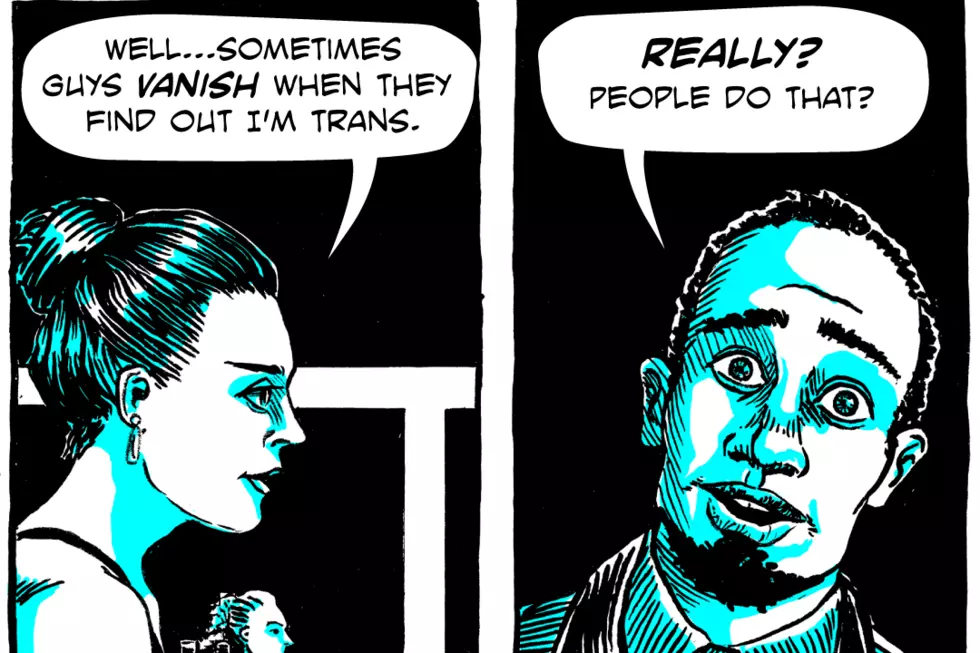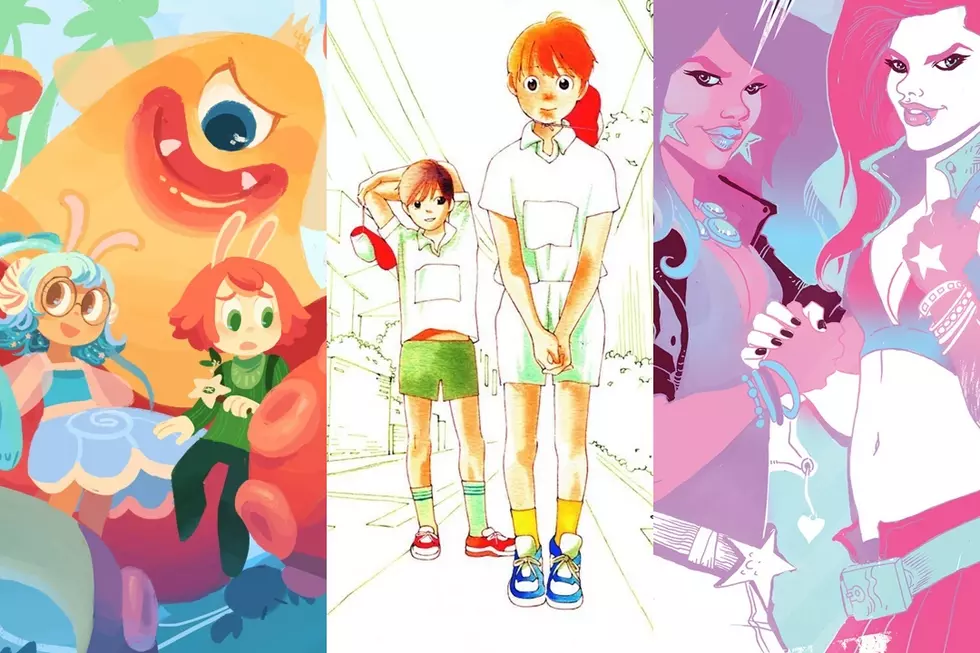![Lost in Transition: ‘Demon Knights’, Shining Knight, And the Power of Clarity [Fantasy Week]](http://townsquare.media/site/622/files/2016/10/demonknights-header.jpg?w=980&q=75)
Lost in Transition: ‘Demon Knights’, Shining Knight, And the Power of Clarity [Fantasy Week]
A few weeks back, my colleague Elle Collins wrote about Wonder Woman, specifically an interview Greg Rucka gave about her sexuality. The article was about how having an explicit statement of sexuality in an interview, and an implicit statement in the comic, were two ends of a rope that are infuriatingly close to meeting, but remain unspliced.
Gender identity and sexuality aren’t the same thing, but they’re often treated the same along one critical vector: treating one mode of gender or sexuality as the default, and others as exceptions to that rule. So I couldn’t help but think of it as I reflected on the character of Sir Ystin, from 2011’s Demon Knights.
Demon Knights spun out of DC’s New 52 relaunch, and was written by Paul Cornell, who has written a slew of wonderful comics, as well as some episodes of a show about a guy in a blue box who talks too fast. (The guy talks too fast, the blue box does not.) The art team is Diogenes Neves, Michael Choi, and Robson Rocha, joined by Julio Ferreira on inks, and they work extremely well together, maintaining a coherent look for the book. Rounding out the team is Marcelo Maiolo on colors and Jared K. Fletcher on lettering.
Demon Knights is set in the distant past of the post-Flashpoint DC Universe, giving the lore of the reborn universe a sense of depth at a time when it felt shallow. A group of rogues, cutthroats, knights, the cursed, and the outcast find themselves in the town of Little Spring, in the path of a marching army. The group must defend the town against the army, and the deeper machinations of its leaders, a cabal of mages who are tied into the recurring death and return of Camelot.
The main thing about Demon Knights that sticks out is that it is dark. Not just in the art, which renders blood, guts and beheadings in extreme detail, but in story content as well.
In the opening story, no fewer than three children are killed, one of them indirectly the fault of the anti-heroes and another a cold-blooded murder by another. Anyone killed by Etrigan is sent to Hell regardless of their sins in life, and abandoning one of said innocent victims to his damnation is a key plot point, which is extremely disturbing to me from an existential point of view. There is a sense that anyone could betray the team at any time. It isn’t over the line for me, but it does make a show of walking up to it, and of course, my line may not be another reader’s line.
In addition to all of the misdeeds listen above, one persistent thing is that, with the exception of King Arthur and the aforementioned damned priest, just about everyone who meets Sir Ystin --- AKA the Shining Knight, a long-lost knight of Camelot from one of the times it fell before --- is extremely fuzzy on Ystin’s gender, calling them a lady despite ‘Sir’ being right there. (Because this is less than clear in the comic itself, I will be referring to Ystin with gender-neutral pronouns throughout this piece.)
It feels like a weird thing to object to, given that Vandal Savage is part of the cast and he’s probably eaten a baby at some point, but even though they’re anti-heroes, they’re still the protagonists of the book, and there’s a difference between behaviors we all know are bad (eating babies is bad, please do not eat babies) and behaviors we still have to fight and argue over (a trans or non-binary person’s pronouns, for example.)
But it turns out that there’s a reason for the confusion, in more ways than one. Later in the story, it’s revealed that Sir Ystin doesn’t see themselves as male or female , but both --- and Sir Ystin says they were "born this way." A Newsarama interview around the same time took the time to clarify this --- or rather, attempt to clarify it, but it doesn’t really succeed.
Cornell says he wants the reader to make up their own mind on Ystin, and that’s normally something I admire in a writer, a willingness to trust the reader. But in the case of something as fundamental as identity, I think some level of clarity is essential, especially if it’s a marginalized identity where the average reader might not know what conclusion they’re jumping to, or any attendant misconceptions about sex and gender they may have.
The interview describes Ystin as intersex, and Cornell later clarifies that he sees Ystin as transgender, and it’s fully possible for Ystin to be both of those things --- but neither of these things are plainly stated in the narrative, which means we’re left unsure how Ystin sees themselves, or even if it’s clear that Paul Cornell or Vaneta Rogers (the person conducting the interview) have the right idea about either of those terms. For clarity’s sake, here’s the short-short version.
Intersex is both an identity and a factor of biology, with the caveat that you can have the biological factors without the identity, but not the identity without the biological factors. It’s when the biological markers of sexual characteristics in a person aren’t as clearly defined as they are typically thought to be. It’s very common, with some estimates placing it at 1 in 2,000. Odds are good that you live in the same city as someone who is intersex. There are a lot of ways to be intersex, because biology is a lot more complicated than the simplified version taught in most high schools --- you can get a group of intersex people in the room and odds are they’re all intersex in different ways.
Being trans is more of a gender identity, distinct from sexual characteristics, a departure from the gender others told you that you had. Anyone, regardless of being biologically intersex, can be transgender. Whether it and its attendant symptoms, such as gender dysphoria, are biological is up in the air, and in some ways irrelevant, because many trans people have no biological symptoms and they’re still trans, because they said so. Gender expression and the biological factor of intersexuality aren’t the same thing --- I know intersex trans people, and while I’m trans, I’m not intersex (as far as I know --- a lot of intersex people don’t, because they’re never told.)
So Ystin could be intersex, trans, both trans and intersex --- or just as likely, any of a bunch of other equally likely things. To my interpretation, Ystin is most likely genderqueer, not fitting a male or female gender binary; bigender, both male and female at once; genderfluid, going back and forth between gender expressions as circumstances and time permits; or any one of the dozens of expressions used on this page.
You get the idea. This stuff is complicated. I’m sorry it got heavy. Here’s some robot dragons.
Robot dragons are awesome. Everything you need to know about them is right there in the name, making them perfect for the monthly superhero comic where a limited page count means being succinct is critical. Marginalization --- along race, along sexuality, along gender lines and different kinds of gender lines --- is complicated, because one of the key factors that feeds into marginalization is that by default, most people don’t know.
They don’t know what it’s like to be intersex, transgender, or some other gender-variant expression; they don’t have the background that lets a writer be succinct in a way that bringing in robot dragons does. So being succinct can fail, and sadly, I feel it fails here, because if I’ve read the comic and then an accompanying interview and l'm still not entirely sure about the character in question --- or if the writer is even sure about the issues being raised --- then something’s gotten lost. In transition.
Complexity and the superhero genre often work at cross purposes. The former needs a level of appreciation for fine details, a commitment to research that’s never-ending; the latter grew out of a character called Superman whose deal is that he’s a super man. There’s room for subtle shading of behavior and all the complexities of life, but there is also a time to state things plainly. The marginalized deserve heroes as much as anyone else; to see a character like themselves, and just as importantly, to know the character is like themselves, and sometimes you need a bold statement to ensure that’s how it’s taken.
Sir Ystin isn’t quite there yet, but I have confidence that with some additional clarifications --- on the page, not just in interviews --- that Ystin could be a sterling, if somewhat blood-soaked, representative of whatever expression Sir Ystin is. As welcome and necessary as trans characters are, they aren’t the only marginalized gender expressions out there, and they all deserve to be seen in the mirrors of ourselves that superheroic characters are supposed to be.
Lost in Transition is a series of articles by Charlotte Finn looking at comics that touch on transgender and genderqueer themes.
More From ComicsAlliance





![Cast Party: Who Should Star In An ‘Amethyst’ Movie? [Fantasy Week]](http://townsquare.media/site/622/files/2016/10/ame_featured.jpg?w=980&q=75)
![Strange Company: The Marvel Mystical Fantasy Draft, Part Three [Fantasy Week]](http://townsquare.media/site/622/files/2016/10/mystic-day-three-feat.jpg?w=980&q=75)
![Witchcraft, Redemption and Family Ties: James Robinson Talks Scarlet Witch [Interview]](http://townsquare.media/site/622/files/2016/10/scarletwitch-feat.jpg?w=980&q=75)
![Dear Friends and Deer Friends in Keezy Young’s ‘Yellow Hearts’ [Webcomic Q&A]](http://townsquare.media/site/622/files/2016/10/YH-Header-for-Jon.png?w=980&q=75)
